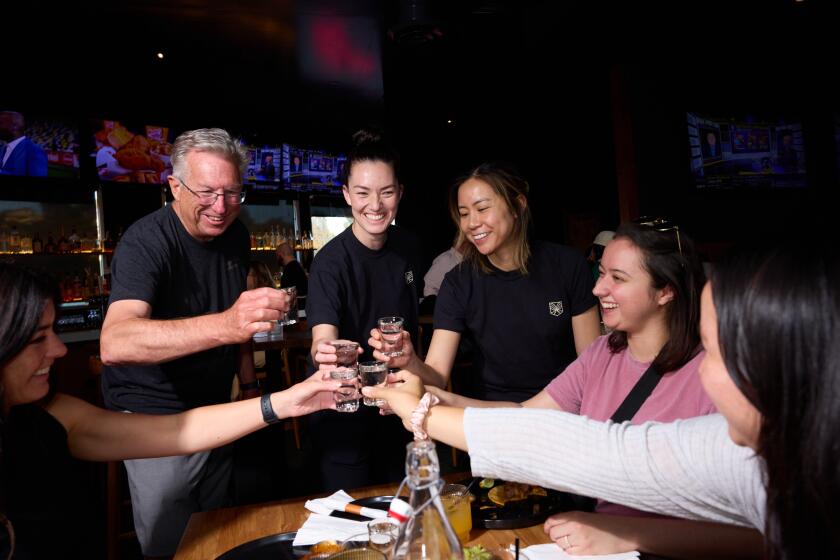Home on the Road : Leisure: The happy wanderers of the country find fellowship and fun with a family-type bonding in clubs that understand the “empty nest syndrome.” All it takes is a recreational vehicle and a feeling of adventure.
- Share via
B. J. and Alta DeGarmo could hardly wait to go to Bakersfield.
Now, Bakersfield isn’t generally one of Southern California’s more compelling destinations, but the DeGarmos weren’t headed there for sightseeing. They were planning to maneuver their motor home among 1,200 other recreational vehicles--motor homes, trailers, vans and campers--park for the week and “party down,” RV-style.
The event was the annual Southern California State Samboree earlier this month, and the DeGarmos of North Hollywood wouldn’t have missed it for the world. They are among 750,000 families in the Good Sam Club, the world’s largest recreational vehicle club. Whenever Good Sam members gather, the fun flies.
At least a million individuals, couples or families belong to one or more RV clubs--proof that, if nothing else, folks don’t just buy RVs to travel.
The RV industry tends to sell a message of freedom and adventure when it promotes its products, as it will during the RV show at Dodger Stadium, Nov. 3-12. But for the legions of RV club members--most of whom do enjoy travel, freedom and adventure--it’s the social connections they make through their clubs that’s their primary raison de voyage .
The DeGarmos were so eager to reunite with fellow members of the Good Sam Club that they planned to arrive Tuesday for an event that would begin Friday.
“I need to get in as much visiting as I can,” Alta DeGarmo said, explaining that the people she has met through the Good Sam Club “have become like family. They’re closer than brothers and sisters. It gets in your blood. The more you go out, the more you meet. Some we see only once a year at a big international Samboree, but when we do, we greet each other, hug. . . . It’s just great.”
Most of the dozens of national RV clubs have local or regional chapters, stage rallies and caravans and provide a framework for making social connections. Good Sam, based in Agoura Hills, has 2,200 chapters nationwide and in Canada, each of which has its own social and travel programs.
Each state holds rallies called Samborees, like the one in Bakersfield. The major international Samboree, held last summer in Sedalia, Mo., drew 2,146 rigs and 4,600 people. International events are also held each year in conjunction with the Rose Parade in Pasadena and the Calgary Stampede in Calgary, Alberta.
K. W. Stevens, director of the National RV Owners Club based in Pensacola, Fla., lists four reasons to join an RV club: “Friends, fellowship, fun and food.” Stevens also cites security as a draw. NRVOC stages 20 or so caravans annually.
“Caravans give people a sense of security, so they’re not always out on the road by themselves,” he said.
Sue Bray, executive director of the Good Sam Club, calls the popularity of RV clubs “the empty nest syndrome.” As with other RV clubs, about half of the Good Sam membership is retired. “Their children are grown up and out of the house and they at last have time to travel. But time isn’t always enough. They miss the family feeling. The club helps provide that.
“People seem to have a longing for a way of life where people would chat with neighbors on the front porch, or just sit and watch the grass grow. Modern life doesn’t allow that. But going to an RV rally, meeting fellow club members, going to a potluck dinner or an ice cream social--it replaces something that has been lost in recent years.”
“Good Samers love to eat a lot,” Alta DeGarmo said. Hence potluck dinners are always popular at a Samboree. Jell-O mold salads are alive and well. Ditto games such as bingo, seminars covering technical and life-style aspects of RVing, commercial exhibits by RV and accessory manufacturers, crafts shows, flea markets, square dancing and nightly entertainment.
Good Samers at a Samboree typically sport waistcoats festooned with commemorative patches and badges from previous RV rallies. They spark instant conversations among strangers. Alta DeGarmo recalls being asked to remain in line at a potluck: “ ‘Wait,’ this woman said, ‘don’t move. I’m not through reading your vest yet.’ ”
The Family Motor Coach Assn., for motor home owners only, is the second largest RV club after Good Sam. FMCA staged its 26th annual national rally in Sacramento the last weekend in September. According to Pamela Kay, editor of FMCA’s magazine, Family Motor Coaching, about 2,000 motor homes filled the Cal Expo fairgrounds for the rally. By day, FMCAers attended seminars in everything from chassis maintenance to microwave cooking, and rocked out to such entertainers as the Osmonds and Carol Lawrence by night. An RV show at the rally included about 600 new motor homes.
“Club members are the people most committed to the RV life style,” says Karen Mason, a spokeswoman for the Recreation Vehicle Industry Assn. “They already own an RV, but they’re likely to trade up to better units.”
Most major RV manufacturers sponsor a club for owners of their brand.
“It certainly fosters brand loyalty,” says Don Wright, vice president of corporate services for the Indiana-based Holiday Rambler Corp. But Wright acknowledges that it’s a strong social bond--more than the brand of RV--that holds the 15,000 members of the Holiday Rambler RV Club together.
“These are people who really do enjoy each other,” Wright said. “They don’t go to our rallies because they own Holiday Ramblers. They go to be with one another. But they’ll continue to buy Holiday Ramblers because they don’t want to leave the club.”
The past summer marked the 25th anniversary of the Holiday Rambler club. To commemorate the occasion, the company produced a limited-edition anniversary trailer equipped with 1960s equipment and graphics. Nostalgic club members quickly bought out the line.
The most attention-grabbing of brand-name clubs is the Wally Byam Caravan Club, whose members are owners of the distinctive aluminum-skin, cigar-shaped Airstream trailers. Airstreams are considered quite luxurious, so ownership is a status symbol in the world of RVs, making the Wally Byam club probably the most status-conscious of the RV clubs. The sight of a few hundred Airstreams in convoy is something that leaves onlookers agog. The club, named for its founder, has 17,000 members.
One brand-name club clings to glory days gone by. The Cortez National Motorhome Club consists of owners of the late and lamented Cortez motor home. The Cortez, first built in 1963, was the forerunner of today’s luxurious home on wheels. The company went under in 1974 during the energy crunch. A group of 50 die-hard Cortez owners revived the brand in 1975, but the venture failed a few years later.
The club formed in 1975, not long after the company first folded.
“We felt like orphans,” Jan Noto of Temple City said. “Sort of like Edsel owners.” She and her husband, Tony, are national directors of the 850-member club. “It’s like a security blanket,” she said. “On the national level, the club is a clearinghouse of information on how to keep your Cortez on the road. On the chapter level, it’s much more social.”
The Notos say Cortez club activities make up “most of our social life. It’s our thing.” When the Notos are on the road, they take along a club roster and phone fellow club members along the way. “We always offer each other a place to park--even strangers.”
In some cases, it’s more than brand name or fun and games that bind together members of an RV club. The Handicapped Travel Club offers handicapped RVers or would-be RVers a chance to share common difficulties and practical solutions. They share information on customizing their vans, motor homes and trailers, and trade travel tips, such as what campgrounds and attractions in a particular area are equipped to handle wheelchairs.
“We do share our frustrations, but that’s not the purpose of the club,” said HTC president Bob Skummer of Mt. Prospect, Ill. Skummer has multiple sclerosis. “We’re not a self-help group. It’s great to be around people who are so open, and share common concerns. No one is embarrassed. We talk about bathrooms, sexual topics, anything that’s on our minds. But that’s not really what the club is for. Our theme is ‘For Fun and Fellowship.’ That’s what it’s all about.”
Another special-interest club is Loners on Wheels, a 3,000-member group of single RVers. But their special interest is not finding a partner.
“It’s a social club,” says George Berry of Lakewood, vice president of the L.A. Loners. “Not a lonely hearts club.” Like any RV club, the Loners have chapters and rallies. But club rules stipulate that two members of the opposite sex cannot arrive together at any function.
“Sure, some hanky-panky goes on,” Berry said. “But the club was formed for single people, and we stick to that. It tends to attract very independent types--folks who are single and want to stay single.”
According to Berry, Loners who join only to look for partners usually don’t last. Those who fail to find romance lose interest in the club; those who do are told to join some other club. No ill feelings; they’re just no longer loners.
Loners on Wheels will celebrate its 20th anniversary at a rally in Death Valley, Oct. 30 to Nov. 4.
For all the potlucks and fellowship, Jell-O mold salads and bingo games, more serious, practical motives underlie club membership for many RVers. At least two clubs, Good Sam and FMCA, function somewhat like the Automobile Assn. of America for RVers. Both clubs offer trip-routing, mail-forwarding, emergency road service and a monthly magazine.
Good Sam, with the clout that accompanies its size, has affiliated campgrounds that offer discounts to members, discount RV financing and credit-card-loss protection. Good Sam also lobbies Congress on issues that affect RVers and sponsors a major charity, Dogs for the Deaf.
One club, the Escapees, has a particularly practical orientation. Members have built nine nonprofit co-op RV campgrounds. Escapee members can own a lot in one park and rent a site in any other co-op park for a low fee. Since the parks are built with volunteer labor--usually skilled but retired RVers--and are not operated for profit, costs are very low.
Joe and Kay Peterson, who have written a number of books for RVers, founded the club 11 years ago, originally as a way for friends who were full-time RVing to stay in touch. In addition to the co-op parks and the usual rallies and gatherings, the Escapees have established a number of RV Retreats--small parcels of land owned by club members that provide free camping, without RV hookups, to any member.
“It’s called boondocks camping,” Joe Peterson said. “In our lectures around the country, Kay and I stress that RVers should utilize the features they pay so much for--the features that make their RVs self-contained. They can save a lot of money that way. We’ve been boondocking for 19 years now. It’s a wonderful life.”
For a list of RV clubs, write to the Recreation Vehicle Industry Assn., P.O. Box 2999, Reston, Va. 22090.
More to Read
Sign up for The Wild
We’ll help you find the best places to hike, bike and run, as well as the perfect silent spots for meditation and yoga.
You may occasionally receive promotional content from the Los Angeles Times.






